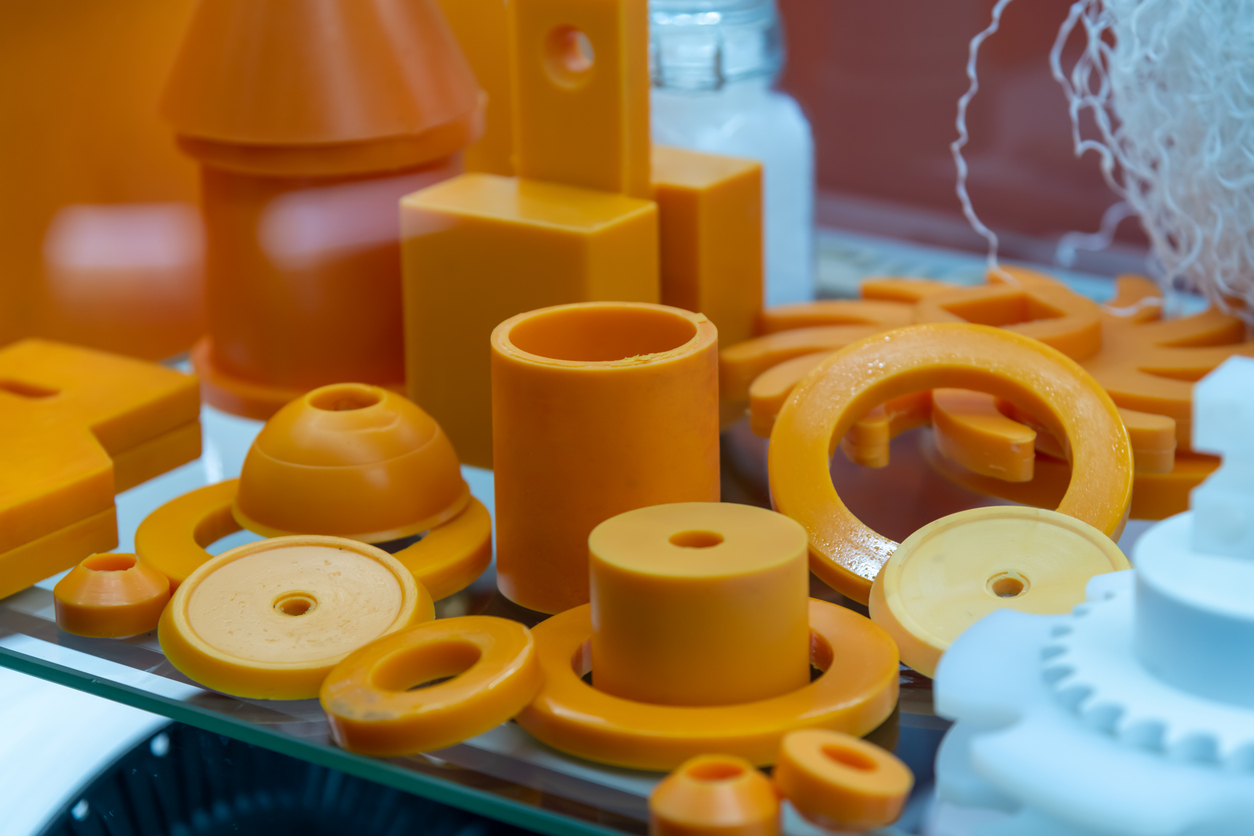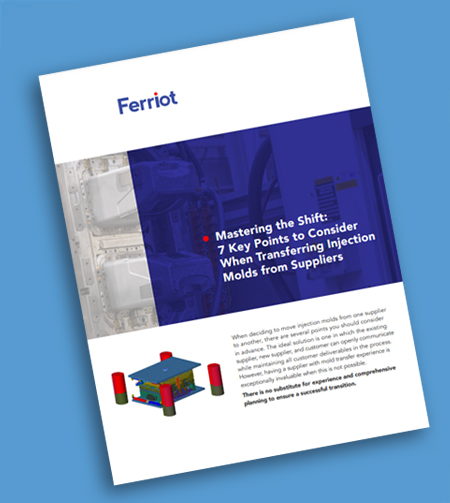When designing parts for injection molding, even the smallest oversight can lead to significant issues later on, such as costly tooling changes, part failures, or production delays. These problems not only disrupt timelines but also increase overall project costs. In industries where precision and reliability are paramount, the consequences can be especially detrimental.
This is where Design for Manufacturability (DFM) becomes indispensable. Early engineering collaboration with a trusted partner like Ferriot helps identify potential injection molding defects before they escalate into expensive setbacks. By taking a proactive approach to DFM, OEMs can ensure that parts are optimized for both functionality and manufacturability from the start, avoiding costly rework down the line.
Let’s take a closer look at how partnering with an experienced molder like Ferriot can help ensure that your project stays on track, on time, and within budget by avoiding some of the most common pitfalls that lead to injection molding defects.
Pitfall #1: Overlooking Wall Thickness Guidelines
One of the most common mistakes in injection molding design is overlooking the importance of consistent wall thickness. When the wall thickness of a part varies significantly, it can lead to a range of injection molding defects such as warping, sink marks, and internal stress.
This is because walls with inconsistent thickness will cool at different rates, which results in shrinkage, warping, and even structure weaknesses. It also makes it more difficult for injection molders to maintain precise dimensions. Voids and bubbles within the part can also be a consequence of non-uniform wall thicknesses.
Altogether, these defects not only compromise the part’s appearance but also affect its functionality, which usually leads to costly rework and delays in production.
The Solution: Design for Manufacturability (DFM) Analysis
At Ferriot, we leverage our DFM analysis to identify and resolve wall thickness inconsistencies early in the design phase. By optimizing part geometry and ensuring uniform wall thickness, we help ensure proper flow and cooling, which in turn maintains structural integrity and high-quality finishes. Through careful analysis, we strike a balance between performance, manufacturability, and cost-efficiency, so your parts not only meet design specifications but also perform optimally under real-world conditions.
Pitfall #2: Ignoring Draft Angles and Associated Injection Molding Defects
When designing injection molded parts, one critical element often overlooked is the draft angle, the slight taper applied to the sides of a part to facilitate its removal from the mold. Proper draft is essential for smooth part ejection and for ensuring the longevity of your tooling.
Without adequate draft, parts can get stuck in the mold, leading to damage during ejection and potentially compromising the surface finish of the part. This can cause injection molding defects like ejection marks, scratches, or even cracks in the molded part. Molds with insufficient draft are also more prone to increased wear, which ultimately leads to more frequent maintenance and higher tooling costs over time.
Incorporating the right draft angles from the outset prevents these issues and enhances tooling efficiency. Best practices for draft typically include angles of 1 to 3 degrees for most parts, though this can vary depending on material, part geometry, and molding process. The key is to ensure that the draft is consistent across all surfaces that need to be released from the mold.
The Solution: Professional Draft Assessments
At Ferriot, our engineering team works closely with customers to assess draft requirements early in the design phase to ensure proper part ejection and minimize tooling wear. We employ advanced mold-flow simulations to verify draft angles and identify any potential issues before tooling is even created. This upfront attention to detail helps avoid costly revisions and ensures smoother production runs, saving time and money in the long run.
Pitfall #3: Designing Without the End-Use Environment in Mind
One of the most critical factors in designing injection molded parts is understanding the end-use environment. This defines the conditions the part will endure once in the field. Failing to account for environmental factors such as temperature extremes, chemical exposure, or load stress can lead to parts that fail prematurely, impacting both product performance and your reputation.
For example, parts designed for medical devices must meet stringent regulatory requirements and be able to withstand conditions like sterilization or exposure to bodily fluids. Using the wrong material in this case could lead to material degradation or failure under stress. On the other hand, parts intended for industrial equipment might need to handle harsh chemicals, high-pressure conditions, or extreme heat. A material that performs well in one environment could be completely inadequate in another.
The Solution: Expert Resin Selection
At Ferriot, we partner with OEMs to ensure accurate resin selection, tailored to the specific demands of each application. Our team takes into account the part’s environment, performance requirements, and any regulatory considerations. Our goal is to help guide material choices that meet all necessary specifications. From biocompatibility for medical devices to chemical resistance for industrial parts, our expertise in material science ensures your parts are designed with the end-use in mind, minimizing the risk of performance failures and ensuring long-term reliability.
Pitfall #4: Overcomplicating the Design Leads to Injection Molding Defects
The temptation to focus solely on the performance needs of a part without considering the practical aspects of moldability is a common pitfall. Complex shapes often require more expensive tooling, as well as additional secondary operations like machining, assembly, or finishing. This not only increases upfront costs but can also create bottlenecks in the production process that slow time-to-market.
Parts that are difficult or inefficient to mold can even lead to injection molding defects, such as warping, uneven fill, or internal stress. These issues can affect product quality, lead to scrap, and require rework, ultimately driving up the total cost of ownership.
The Solution: Part Consolidation
OEMs shouldn’t have to sacrifice part performance for manufacturability. The key is part consolidation — the process of designing multiple parts into a single, more efficient component. Ferriot uses mold-flow analysis and other advanced simulation tools to evaluate part designs early on, identifying potential issues with complex geometries before they reach production. This allows us to simplify designs while ensuring that the part still meets all necessary performance standards.
By leveraging our expertise, OEMs can reduce tooling costs, minimize secondary operations, and improve manufacturing efficiency, all without compromising the functionality or durability of the final product.
Pitfall #5: Late-Stage Design Changes and Potential Injection Molding Defects
And finally, one of the most costly mistakes in injection molding is making late-stage design changes after tooling has already been started or, worse, once production has begun. Modifying molds at this stage can lead to significant delays, increased costs, and even potential injection molding defects that could impact the quality and performance of the final product.
The Solution: Early Collaboration with a Skilled Injection Molding Partner
To avoid these pitfalls, early and thorough collaboration with the engineering team is crucial. At Ferriot, we place a strong emphasis on locking in a stable, mold-ready design well before the tooling process begins. Our Design for Manufacturability (DFM) reviews are instrumental in assessing every aspect of the part, from material selection to part geometry, ensuring that designs are optimized for both manufacturability and performance.
We also offer prototyping services that allow OEMs to test part designs in the real world before committing to full-scale production. By using prototypes to identify potential issues early, we can make minor adjustments that avoid costly surprises later in the process. This proactive approach reduces the risk of late-stage design changes and ensures a smooth and efficient production flow.
How Ferriot Helps You Avoid These Pitfalls
At Ferriot, we believe avoiding injection molding defects starts with proactive, early-stage design support. From concept through production, we collaborate closely with OEMs to ensure each part is optimized for manufacturability, performance, and cost-efficiency.
Using advanced simulation tools and mold-flow analysis, our team can predict material behavior, flag potential issues, and validate designs before tooling begins. Prototyping services allow OEMs to test and refine parts in real-world conditions, minimizing the risk of late-stage changes.
Our in-house engineering reviews offer expert insight at every step — whether you’re finalizing complex geometries or selecting the right material for your application. By taking a collaborative approach, we help OEMs avoid costly mistakes, reduce rework, and hit production targets faster.
Have a design ready — or just an idea on paper?
Let Ferriot help you avoid common pitfalls and turn your concept into a production-ready part. Connect with our team today to get started.



